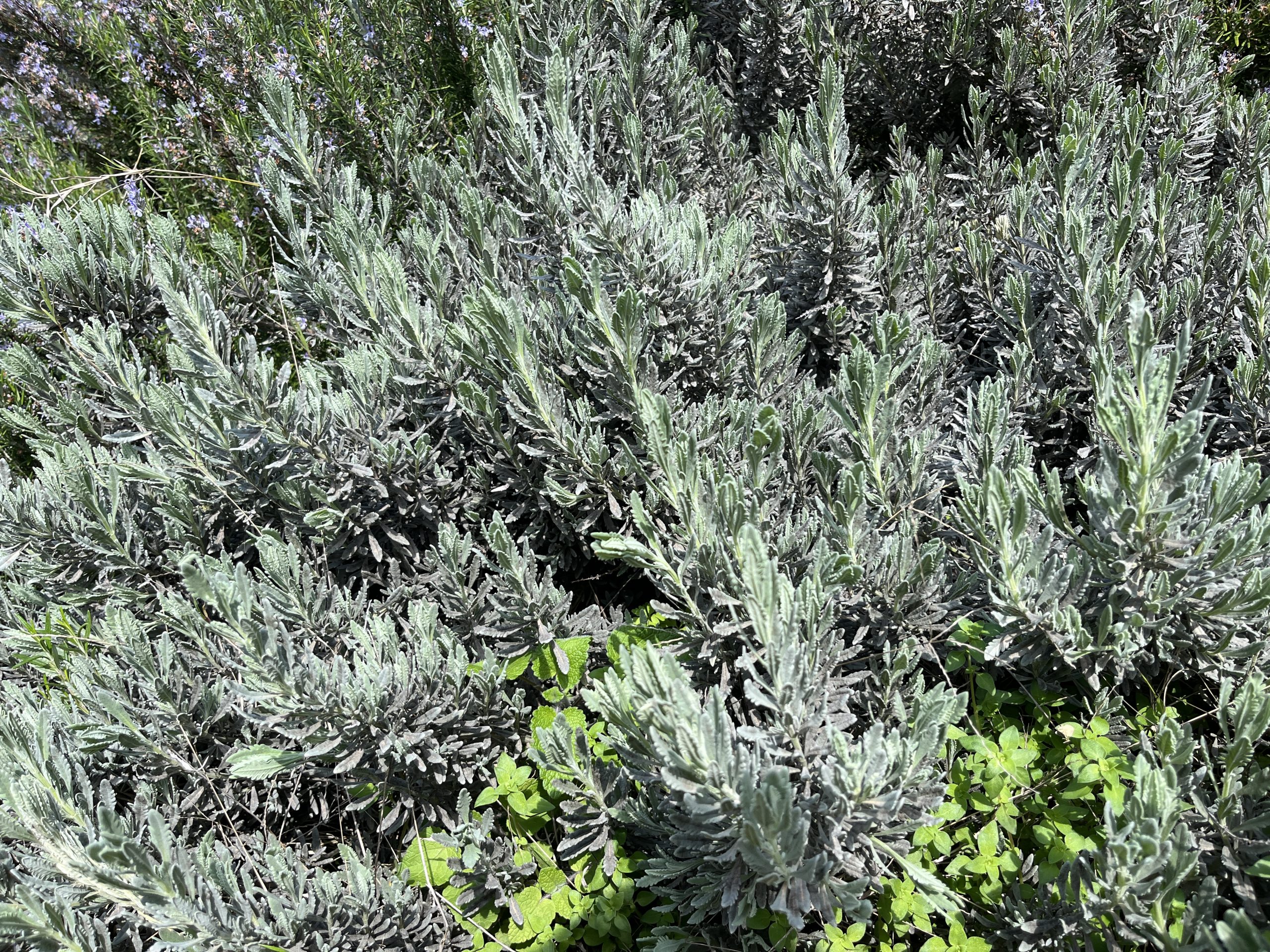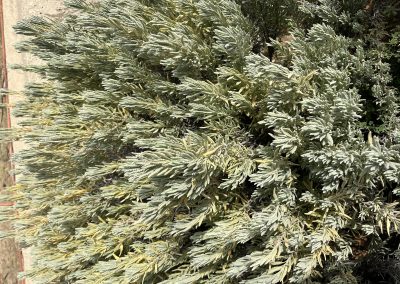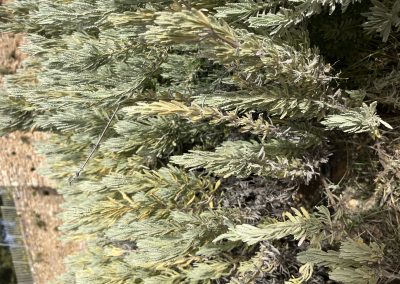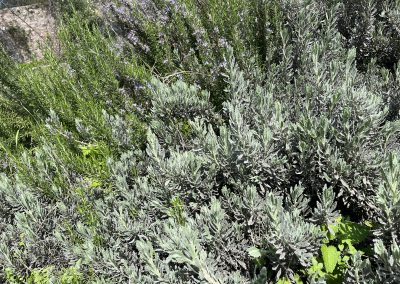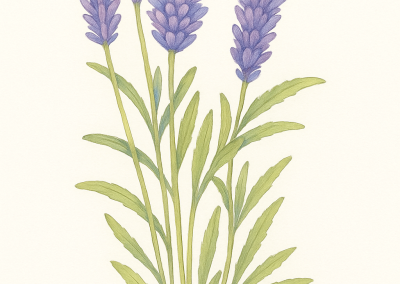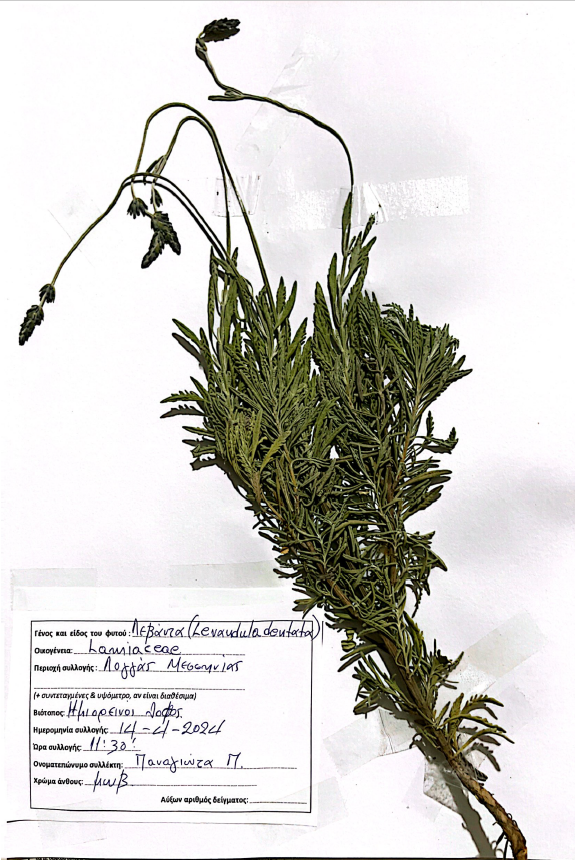Lavandula dentata
Scientific description
Scientific name: Lavandula dentata
Kingdom: Plantae
Clade: Tracheophytes, Angiosperms, Eudicots, Asterids
Order: Lamiales
Family: Lamiaceae
Genus: Lavandula
Species: Lavandula dentata
Origin:
Native to southern Europe and Arabia. The name "lavender" comes from Latin lavāre, meaning "to wash" or "to cleanse".
Description:
Perfect flowers (androgynous/bisexual) with both male and female organs. Ornamental shrub, 0.5–1 m tall, 1–1.5 m wide. Takes 2–5 years to reach full size. Dense foliage of long, small, serrated leaves, silvery green, aromatic. Flowers mid–late summer, on long stems, blue-purple, intensely fragrant.
Propagation:
By seed or cuttings; seed propagation more difficult.
Ecology:
Suitable for flower beds, borders, pots, planters, balconies, entrances, fences, natural partitions, wall/path edges, small or large clumps, herb gardens, slopes, rock gardens, gravel gardens, Mediterranean-style dry gardens, urban/country/island gardens.
Uses:
Lavender oil aids burn healing, antimicrobial, anti-inflammatory, aromatherapeutic effects for anxiety.
Επιστημονική ονομασία: Λεβάντα η οδοντωτή (Lavandula dentata)
Βασίλειο: Plantae
Clade: Tracheophytes, Angiosperms, Eudicots, Asterids
Τάξη: Lamiales
Οικογένεια: Lamiaceae
Γένος: Lavandula
Είδος: Lavandula dentata
Καταγωγή:
Από νότια Ευρώπη και Αραβία. Το όνομα «lavender» προέρχεται από την λατινική λέξη lavāre που σημαίνει πλένω, καθαρίζω.
Περιγραφή:
Τέλεια άνθη (ανδρόγυνα/αμφιφυλόφιλα). Διακοσμητικός θάμνος, ύψος 0,5–1 m, πλάτος 1–1,5 m. Χρειάζεται 2–5 χρόνια για πλήρες μέγεθος. Πυκνό φύλλωμα μακρόστενα μικρά φύλλα, οδοντωτά, ασημένιο-πράσινα, αρωματικά. Άνθη μέση–τέλη καλοκαιριού, σε μακριά στελέχη, μπλε-μωβ, έντονα αρωματικά.
Πολλαπλασιασμός:
Με διαίρεση φυτού, μοσχεύματα (μαλακά άνοιξη, ξυλοποιημένα φθινόπωρο) ή σπόρο (δυσκολότερη).
Οικολογία:
Κατάλληλη για παρτέρια, μπορντούρες, γλάστρες, ζαρντινιέρες, μπαλκόνια, εισόδους, φράκτες, φυσικά χωρίσματα, άκρες τοίχων/μονοπατιών, μικρές ή μεγάλες συστάδες, βοτανόκηπους, πλαγιές, βραχόκηπους, κήπους με χαλίκια, ξηρικούς κήπους, μεσογειακού στυλ, αστικούς, εξοχικούς, νησιωτικούς κήπους.
Χρήση:
Έλαιο λεβάντας βοηθά στην επούλωση εγκαυμάτων, αντιμικροβιακό, αντιφλεγμονώδες, αρωματοθεραπευτικά για άγχος.
Nom scientifique: Lavandula dentata
Règne: Plantae
Clade: Trachéophytes, Angiospermes, Eudicotylédones, Astéridées
Ordre: Lamiales
Famille: Lamiacées
Genre: Lavandula
Espèce: Lavandula dentata
Origine:
Sud de l’Europe et péninsule Arabique. « Lavande » vient du latin lavāre = laver/purifier.
Description:
Fleurs parfaites (androgynes/bisexuées). Arbuste ornemental 0,5–1 m haut, 1–1,5 m large. Croissance 2–5 ans. Feuillage dense, feuilles longues, petites, dentelées, vert argenté, parfumées. Fleurs mi-fin été, longues tiges nues, bleu-violet, très parfumées.
Propagation:
Par graines ou boutures, graines plus difficiles.
Écologie:
Massifs, bordures, pots, jardinières, balcons, entrées, clôtures, cloisons naturelles, bordures de murs/chemins, petits/grands massifs, jardins aromatiques, pentes, rocailles, jardins secs méditerranéens, jardins urbains, ruraux, insulaires.
Utilisation:
Huile de lavande pour cicatrisation brûlures, antimicrobienne, anti-inflammatoire, aromathérapie pour anxiété.
Denumire științifică: Lavandula dentata
Regn: Plantae
Cladă: Tracheofite, Angiosperme, Eudicotiledone, Asteride
Ordin: Lamiales
Familie: Lamiaceae
Gen: Lavandula
Specie: Lavandula dentata
Origine:
Sudul Europei și Arabia. Numele „lavandă” vine din latină lavāre = a spăla, a curăța.
Descriere:
Flori perfecte (androgine/bisexuale). Arbust ornamental, 0,5–1 m înălțime, 1–1,5 m lățime. Durează 2–5 ani să atingă dimensiunea finală. Frunziș dens, frunze lungi, mici, zimțate, verde-argintiu, parfumate. Flori mijloc–sfârșit de vară, tulpini lungi, albastre-violet, intens parfumate.
Înmulțire:
Prin semințe sau butași, semințe mai dificil de cultivat.
Ecologie:
Straturi de flori, borduri, ghivece, jardiniere, balcoane, intrări, garduri, pereți despărțitori naturali, margini pereți/alei, pâlcuri mici/mari, grădini aromatice, pante, grădini de stâncă, grădini uscate mediteraneene, urbane, rurale, insulare.
Utilizare:
Uleiul de lavandă ajută la vindecarea arsurilor, antimicrobian, antiinflamator, aromaterapie pentru anxietate.
Creative writing inspired by Lavandula dentata
Lavandula dentata — The Gentle Healer
In an ancient village nestled on the mountain slopes, the inhabitants lived in harmony with nature, gathering herbs and flowers for healing and fragrance. The most beloved plant of all was Lavender, known for its soft purple color and sweet, calming scent. Lavender not only soothed the body and mind but was also said to carry a magical story.
According to legend, there once lived a young woman named Laventia, who was blessed by the gods with the power to heal any creature, human or animal, with her touch. However, there was a limitation to her gift: every time she healed someone, she lost a bit of her own strength and energy. Despite this, Laventia never stopped helping people, even when she began to feel weak.
One day, a great war broke out in the land, and many injured people came seeking her help. Laventia, though exhausted, continued to heal tirelessly. But eventually, her strength was completely depleted, and she fell gravely ill. The villagers, desperate, didn’t know how to save her, as there was no cure for her condition.
Then, one night, the goddess of nature, Gaia, appeared in Laventia’s dream. “My child,” she said, “your love and sacrifice for others have not gone unnoticed. Therefore, I will give you a gift: from your sacrifice will grow a plant that will bring peace and healing to all, just as you did. It will be soft yet resilient, like your spirit, and its scent will remind the world of the sweetness of the love you offered.”
The next day, when Laventia passed away, soft purple flowers bloomed on the hills around the village. The people called this plant Lavender, in her honor. The scent of lavender carried the power to soothe the wounds of both body and soul, just as Laventia had done in life. The villagers learned to use lavender for healing, and its gentle fragrance filled homes and temples, reminding all of the woman who had saved them through her selfless love.
From that day forward, lavender became a symbol of calm, love, and healing. Everyone cultivated it to honor Laventia’s gentle heart, and every time its scent filled the air, people believed her spirit still wandered among them, bringing peace.


